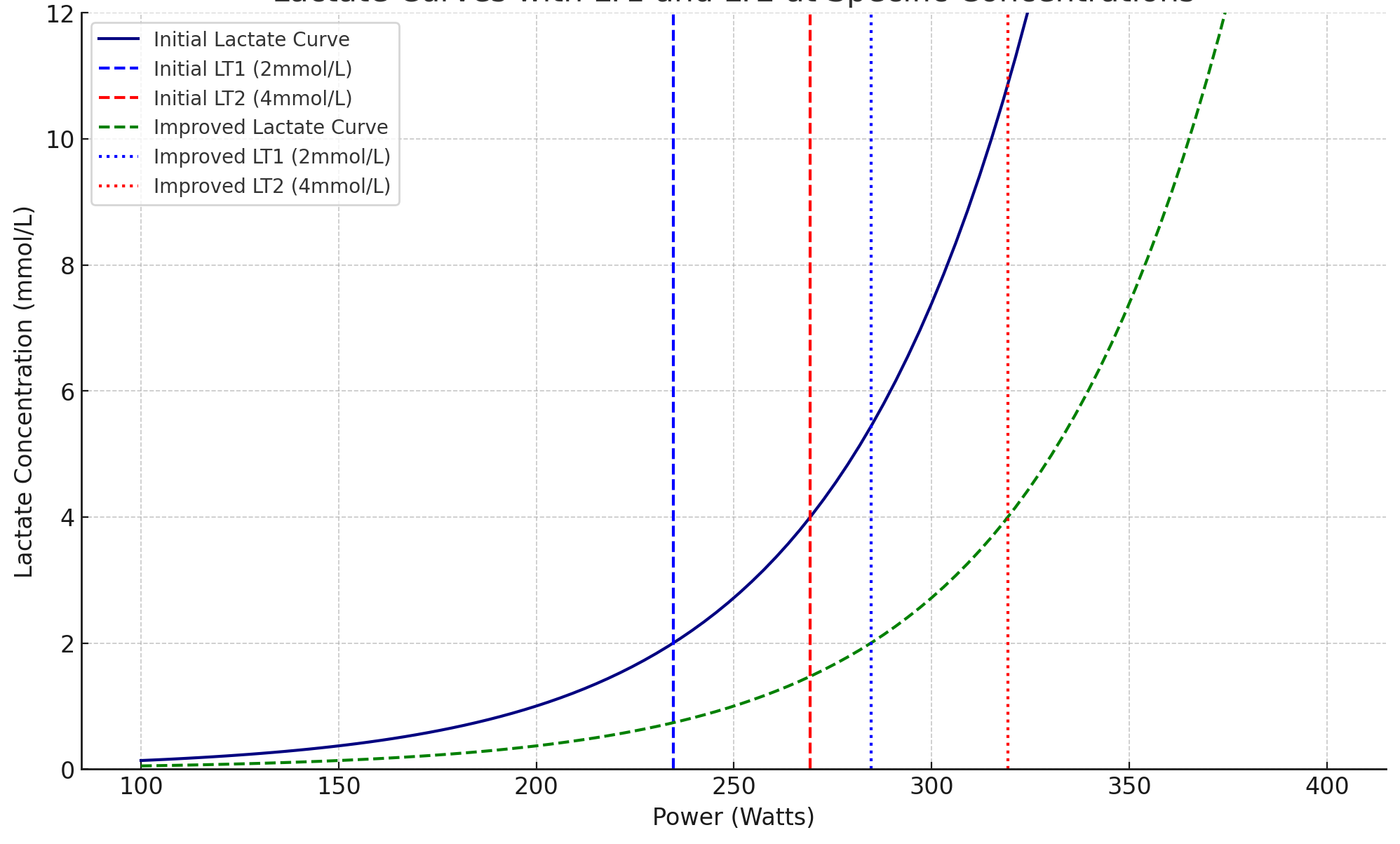
To Understand Your Limits, First You Must Test Them.
At Saddle Up Cycling, understanding your body's physiology is crucial for your cycling performance. Lactate testing is a vital part of this. It's not just about how fit you feel; it's about knowing how your body deals with stress during exercise. We can clearly understand your fitness by measuring your lactate levels during a workout.
The test involves exercising at different intensities, and as the intensity increases, we see how much lactate your body produces. This helps us find your LT1 and LT2 - two critical points where your body starts to produce lactate more quickly. Knowing these can help you set the proper training and performance intensities.
We can help you train more effectively by looking at your metabolic profile. You'll know when to push harder and when to ease off, ensuring every session is targeted towards improving your performance. With lactate testing, you'll have the data you need to train better and cycle stronger.
Why Lactate Testing Matters
Lactate testing fine-tunes training by giving a clear picture of your metabolic thresholds. The benefits include:
Training Zone Customisation: You can structure your training to target specific zones. You can set precise training intensities by boosting your endurance or improving your capacity for intense efforts.
Monitoring Development: By building lactate testing into your plan and completing a test at the start of a new phase, you can track improvements in your body’s abilities.
Avoiding Excessive Training: Overtraining can hinder progress. Lactate levels can inform whether training intensity is appropriate or pushing you into a counterproductive zone.
Personalised Training Approach: No two cyclists are the same. Testing acknowledges this diversity. We can use your test results to craft a training plan tailored just for you.
Ready to Take the Next Step?
Whether you're a competitive cyclist aiming for podium finishes or a fitness enthusiast looking to achieve personal milestones, we're here to empower you with knowledge. Our mission is simple: to provide the tools and insights you need to reach new heights in your athletic journey. For your convenience, we provide the option of conducting lactate testing at your location or out on the road, as long as you're within London and the surrounding areas. This flexibility allows us to cater to your schedule, ensuring that you can benefit from our services in a way that best suits you.
To book a session, Contact us and proceed with your payment below once details have been finalised.
When you choose our lactate testing services, it's not just about the test itself. We're committed to simplifying the process for you, so our pricing includes the necessary testing materials and the valuable data evaluation.

Book your Test Here
Lactate Profile Test: This test assesses your LT1 and LT2 thresholds, providing insights into how your body responds to increasing exercise intensities. It's crucial for planning your training strategy, particularly for managing endurance and high-intensity efforts.
MLSS: Alternatively, you can opt for the Maximal Lactate Steady State test. This test determines your highest sustainable intensity where lactate production and clearance are balanced. It's especially beneficial for endurance athletes, helping to pinpoint the most effective intensity for prolonged efforts.
-
Fasting: Ensure to fast for at least 1 hour before the test.
Substance Avoidance: Refrain from consuming caffeine, alcohol, and nicotine for at least 24 hours beforehand.
Rest: A restful sleep the night before the test is beneficial.
Waiver and Instructions: Participants must sign a waiver and will receive detailed instructions before the test.
-
Setup: Conducted on a stationary bicycle with a turbo trainer.
Warm-Up: A gentle warm-up, with the intensity increasing at set intervals (typically every 6 minutes).
Monitoring: Collection of Heart Rate, Power Output, and RPE (Rate of Perceived Exertion) throughout the test.
Blood Sampling: A small blood sample is collected from the finger or earlobe at each stage to gauge blood lactate levels.
Duration: Typically lasts 45-60 minutes but may end earlier if necessary, particularly if symptoms like fatigue, breathlessness, or dizziness occur.
-
Setup: Conducted on either a stationary bike with a turbo trainer indoors or a suitable setup outdoors on a circuit or climb.
Warm-Up: A 15-minute gradual warm-up, reaching 80-90% of the initial test stage power.
Test Stages:
Stage 1: Begin with a 10-minute effort below the estimated MLSS (10W lower).
Subsequent Stages: Increase power by 10W for subsequent 10-minute stages if lactate rises ≤1mmol/L.
Blood Sampling: Blood samples taken at 3 and 9 minutes of each stage.
Monitoring: Continuous monitoring of Heart Rate, Power Output, and RPE.
Duration: Typically 45-60 minutes but may be terminated earlier based on participant comfort or safety.
-
Immediate Feedback: The preliminary findings regarding heart rate and power output will be shared with the participant immediately after the test. This quick feedback provides an initial understanding of the athlete's performance and any noticeable physiological responses observed during the test.
Detailed Report: A comprehensive report will be prepared and delivered within a few days following the test. This report will thoroughly analyse lactate thresholds, complete heart rate and power data, RPE values, and blood lactate measurements. The study will inform the athlete’s capacity, establish training intensity zones, and offer insights for potential improvements in performance and endurance. Recommendations for future training and possible adjustments will be tailored to the athlete’s specific needs and goals.
The Science Behind Lactate Testing
Lactate thresholds, commonly referred to as LT1 and LT2, are the cornerstones of lactate testing. These thresholds represent specific exercise intensities at which your body's lactate production exceeds its clearance rate. Understanding these thresholds is like having a roadmap to your body's inner workings:
LT1 (First Lactate Threshold):
LT1, or the first lactate threshold, is a significant physiological marker for endurance athletes. It signifies the intensity at which lactate accumulates in the blood faster but not to the extent that it can't be cleared efficiently. Up to this point, the body primarily relies on aerobic metabolism - using oxygen to produce energy.
When you exercise below LT1, you're in a zone where you can maintain steady-state exercise for hours, as the lactate produced by your muscles is removed as quickly as it's made. LT1 is often used to guide long-duration and low-intensity training sessions. Fat as a fuel is also maximised, which is crucial for long-distance events.
Finding your LT1 can be helpful for training paces, especially in endurance sports like cycling or running. Training just below LT1 can improve your body's efficiency at using fat for fuel and increase your exercise intensity while remaining in the aerobic zone.
Understanding your LT1 allows you to structure your training to improve your aerobic base, which is the foundation for higher-intensity efforts and overall athletic performance. By frequently exercising at or slightly above LT1, you can raise this threshold over time, allowing you to perform at a higher intensity while still staying aerobic, delaying the onset of fatigue and improving endurance.
LT2 (Second Lactate Threshold) / MLSS Maximal Lactate Steady State:
LT2 and MLSS are two sides of the same coin, representing critical points in your exercise intensity. LT2 is the level at which lactate accumulates faster than your body can clear it out, marking a shift to more anaerobic (oxygen-independent) energy production. It's also known as the anaerobic threshold or lactate turn point. At this threshold, your body is telling you it's going anaerobic, which means you're starting to work in an effort zone that you can't maintain indefinitely due to rising lactate levels, causing increased acidity and fatigue.
MLSS is closely related to LT2, referring to the highest intensity at which lactate levels in your blood stabilise despite a high work rate. Essentially, it's the intensity you can maintain over time without seeing a continuous rise in lactate concentration in your blood. It's the effort level you can sustain in more extended events, like a time trial, without burning out too quickly.
Training at or slightly below these thresholds is incredibly beneficial. It boosts your body's ability to handle lactate, letting you work harder for longer before feeling fatigued. Understanding and utilising your LT2 and MLSS is vital for endurance athletes, especially cyclists and runners. It informs your training intensity, helps set your race pace, and allows you to perform at your peak without hitting the wall too soon.



